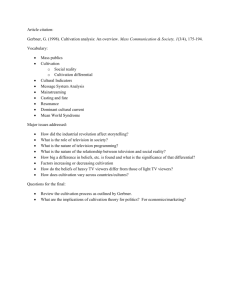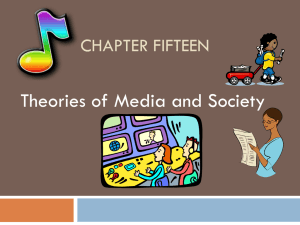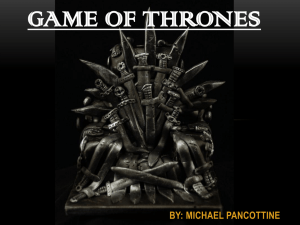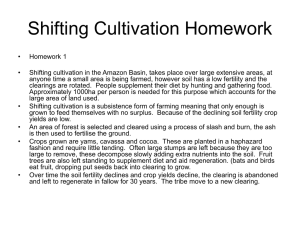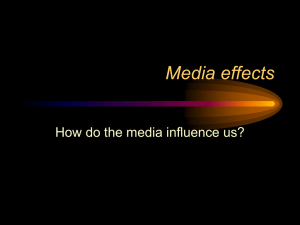Cultivation Theory
advertisement
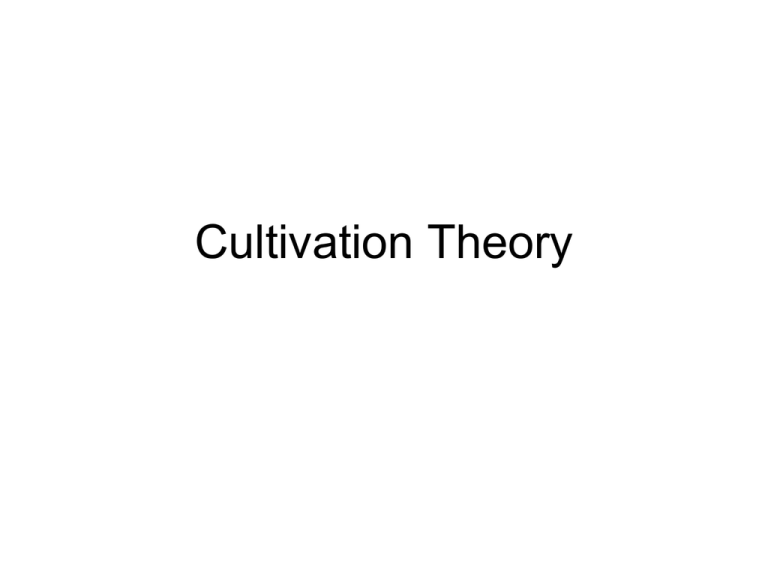
Cultivation Theory Cultivation Theory • Developed by George Gerbner in the late 1960s, it represented a shift from the limited effects paradigm of Paul Lazarsfeld that had dominated since the 1940s. • Cultivation theory (also called cultivation analysis) is called a stalagmite theory Cultivation Theory • Because it suggests that media effects occur like the slow buildup of formations on cave floors, which take their interesting forms after eons of the steady dripping of limewater from the cave ceilings above. Origins of Cultivation Theory • As a perspective, cultivation developed in the context of the increasing growth of television. Gerbner established the “Cultural Indicators” research project, to study whether and how watching television may influence viewers' ideas of what the everyday world is like. Cultivation Theory Principles • Suggests that television is responsible for shaping, or ‘cultivating’ viewers’ conceptions of social reality. • The combined effect of massive television exposure by viewers over time subtly shapes the perception of social reality for individuals and, ultimately, for our culture as a whole • Cultivation theorists argue that television has long-term effects which are small, gradual, indirect but cumulative and significant. Cultivation Theory Conceptual Model Cultivation Theory • According to Gerbner, the main thing that people saw on television was violence and he was especially concerned that it “cultivated” the view among people that the world was a violent place • What was dramatic violence according to Gerbner ? Cultivation Theory • He defined it as “ the overt expression of physical force (with or without weapon), compelling action against one’s will on pain of being hurt and/or killed or threatened to be so victimized, as part of the plot.” • Included: Dramas, cartoons, news and news magazines Cultivation Theory • Gerbner and his colleagues studied television programming for 22 years. Each year, they randomly selected a week and recorded prime time programming as well as children’s weekend programming. • Identified quantity of violence in programs and found these to be stable over time. For instance, dramas that include violence, averaged 5 violent incidents per viewing hour. Cultivation Theory • However, they found significant inequalities in victimhood with older people, women and minorities particularly at risk. • So even though minorities were underrepresented on television, when they appeared, they were much more likely to be victims of violence Cultivation Theory • To analyze the effects of the violence, Gerbner correlated the data from his content analysis of television with survey data from people who were classified based on the amount of time they spent watching television and questioned about their views on violence in the world. Cultivation Theory • Gerbner classified people into two groups: • Heavy watchers (over 4 hours per day) • Light Watchers (less than 2 hours per day) He predicted that heavy viewers saw the world as more dangerous than light viewers. Cultivation Theory • Using a survey, he targeted four attitudes 1. Chances of Involvement with violence Light viewers predicted their weekly odds of being involved in violence were 1 in 100 while heavy viewers said it they were 1 in 10. Cultivation Theory 2. Fear of walking alone at night Women were more afraid than men, but both sexes who were heavy viewers, overestimated criminal activity, believing it to be ten times more than figures indicate. Cultivation Theory 3. Perceived activity of police Heavy viewers believed that about 5% of society is involved with law enforcement. In comparison, light viewers estimated 1 %. Cultivation Theory 4. General mistrust of people People who were heavy viewers tended to see other people’s actions and motives more negatively. Gerbner called this “the mean world syndrome” Cultivation Theory Based on this research, Gerbner sought to quantify in percentage terms the differences in the answers of light and heavy television viewers about violence in the world. He called this “the cultivation differential.” Cultivation Theory The Cultural Indicators research thus indicated that heavy viewers were susceptible to a perception that the world was a dangerous place. Cultivation Theory • The Cultural Indicators project of Gerbner also found that heavy watching of television affected viewers through “mainstreaming” and “resonance.” Mainstreaming is the process by which heavy viewing of television resulted in a similarity of perspective among viewers who varied in education and economic class. Cultivation Theory With regard to mainstreaming, Gerbner argued that unlike radio which focused on very narrow slices of the audience, television sought a broader audience which it homogenized so that heavy viewers had similar views which they self-identified as “mainstream.” Cultivation Theory • Resonance is the process by which heavy viewing of television affects viewers who have first-hand experience of violence. Gerbner argued that the portrayal of violence causes viewers to relive the experience over and over again. • “ The congruence of the television world and real-life circumstances may resonate and lead to markedly amplified cultivation patterns.” Cultivation Theory in Other Contexts Hargreaves and Tiggemann undertook a study in 2003, to apply this approach to the impact of images of undernourished women that appeared in television ads on girls. They showed different sets of ads to two groups of girls, one set with the undernourished women and one set without. Cultivation Theory • They found that the girls who saw the ads with the very thin models, not only had immediate episodes of insecurity and distress about their weight, but that two years later they had greater dissatisfaction with their bodies, as compared to the other group of girls. Cultivation Theory • The researchers concluded that a feasible "link between individual reactive 'episodes' of dissatisfaction in response to specific media images and the development of body image is that enduring attitudes, beliefs, and feelings about bodies and appearance accumulate over time through repeated exposure to ideals of attractiveness in the media"
